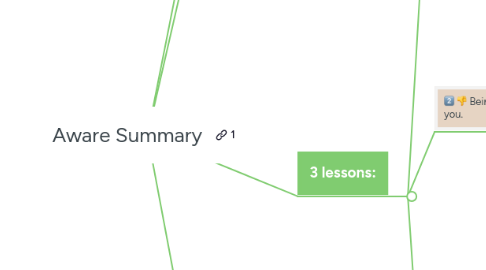
1. 1-Sentence-Summary:
1.1. Aware is a comprehensive overview of the far-reaching benefits of meditation, rooted in both science and practice, enriched with actionable advice on how to practice mindfulness.
2. Favorite quote from the author:
2.1. "How intention glows determines where attention goes, neural firing flows, and neural and interpersonal connection grow." - Daniel Siegel
3. 3 lessons:
3.1. Mindfulness results from optimal interaction between attention, open awareness and intention.
3.1.1. Siegel refers to mindfulness as a modus operandi which is profoundly different from the ordinary functioning of the mind.
3.1.2. Mindfulness builds on three major mental faculties, or the “three pillars” of mindfulness:
3.1.2.1. Attention
3.1.2.1.1. It is the ability to focus on one task or object. It works like a laser, concentrating on one point while ignoring the rest.
3.1.2.2. Open awareness
3.1.2.2.1. This is the ability that allows you to be receptive to your surroundings and read the context.
3.1.2.2.2. The faculty of open awareness allows a football player to maintain a sense of how the rest of his team is spread on a pitch, as he’s dribbling the ball.
3.1.2.3. Intention
3.1.2.3.1. It allows you to maintain a positive and compassionate attitude towards yourself and the world.
3.1.3. Mindfulness arises when these three elements interact with one another in an optimal way.
3.1.3.1. This allows you to perceive the events of life as they unfold, without judgment or excessive rumination.
3.2. Being mindless is virtually never good for you.
3.2.1. Mindlessness is common when you go through your daily chores – for example, brushing your teeth, taking shower, making breakfast and eating it while thinking of something else.
3.2.2. The autopilot is useful in those instances. It allows you not to waste your conscious mental power on repetitive, mundane activities.
3.2.2.1. Our brains evolved an “automatic mode” to economize on energy.
3.2.3. The problem begins when you take the same attitude to less predictable situations, which demand you to engage with them
3.2.3.1. Such situations are your relationships, challenges at work and even driving through the city traffic.
3.2.3.2. Then, it is in your best interest to make decisions based on what is right in front of your eyes – rather than trusting your autopilot.
3.2.4. One study has demonstrated that being mindless in everyday situations may harm our long-term well-being, due to lapses of attention and memory failures it causes.
3.3. Cultivating mindfulness is useful when fighting addictions.
3.3.1. The benefits of mindfulness encompass both your mental and physical health.
3.3.1.1. The most-researched examples include improved immunity, slowed aging process, sharpened problem-solving skills and much more.
3.3.2. Mindfulness can also help us tackle all kinds of addictions.
3.3.2.1. That’s because by becoming more aware, we are empowered to see the cycle of addictive behavior for what it really is.
3.3.2.2. This in itself is often enough to break out of that cycle.
3.3.3. Any addiction is fuelled by dopamine releases in the body.
3.3.3.1. Dopamine is a substance that makes us feel happy and rewarded.
3.3.3.2. Any addiction is simply an over-attachment to a specific external trigger (like substance ingestion) that causes its releases.
3.3.3.3. The problem is that, with time, the effect of the “dopamine hit” wears off. As we want more of it, we continue addictive behaviors.
3.3.4. With mindfulness training, you become empowered to cease these behaviors.
3.3.4.1. Some studies have shown that that’s due to our increased ability to discern between what we need, as opposed to what we would like to have.
3.3.4.2. This differentiation makes the addictive behavior less appealing, which is likely to result in dropping the addiction over time!
